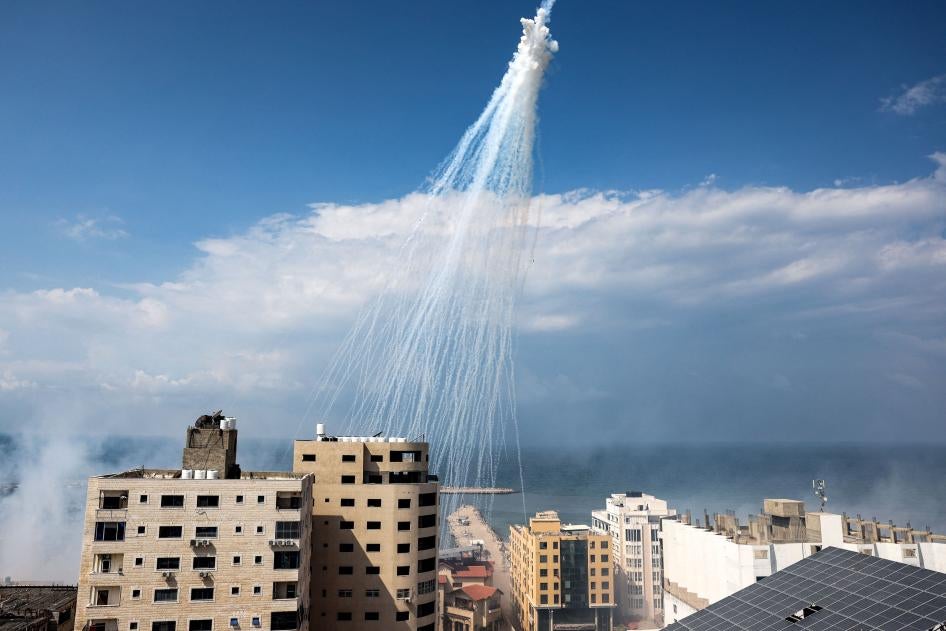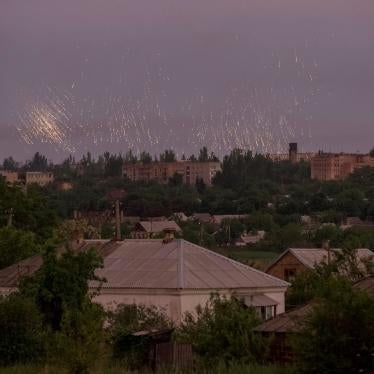(Beirut, October 12, 2023) – Israel’s use of white phosphorus in military operations in Gaza and Lebanon puts civilians at risk of serious and long-term injuries, Human Rights Watch said today in releasing a question and answer document on white phosphorus. Human Rights Watch verified videos taken in Lebanon and Gaza on October 10 and 11, 2023, respectively, showing multiple airbursts of artillery-fired white phosphorus over the Gaza City port and two rural locations along the Israel-Lebanon border, and interviewed two people who described an attack in Gaza.
White phosphorus, which can be used either for marking, signaling, and obscuring, or as a weapon to set fires that burn people and objects, has a significant incendiary effect that can severely burn people and set structures, fields, and other civilian objects in the vicinity on fire. The use of white phosphorus in Gaza, one of the most densely populated areas in the world, magnifies the risk to civilians and violates the international humanitarian law prohibition on putting civilians at unnecessary risk.
“Any time that white phosphorus is used in crowded civilian areas, it poses a high risk of excruciating burns and lifelong suffering,” said Lama Fakih, Middle East and North Africa director at Human Rights Watch. “White phosphorous is unlawfully indiscriminate when airburst in populated urban areas, where it can burn down houses and cause egregious harm to civilians.”
On October 11, Human Rights Watch interviewed by phone two people from the al-Mina area in Gaza City, who described observing strikes consistent with the use of white phosphorus. One was in the street at the time, while the other was in a nearby office building. Both described ongoing airstrikes before seeing explosions in the sky followed by what they described as white lines going earthward. They estimated that the attack took place sometime between 11:30 a.m. and 1 p.m. Both said that the smell was stifling. The person who was in his office said that the smell was so strong that he went toward the window to see what was happening and then filmed the strike.
Human Rights Watch reviewed the video and verified that it was taken in Gaza City’s port and identified that the munitions used in the strike were airburst 155mm white phosphorus artillery projectiles. Other videos posted to social media and verified by Human Rights Watch show the same location. Dense white smoke and a garlic smell are characteristics of white phosphorus.
Human Rights Watch also reviewed two videos from October 10 from two locations near the Israel-Lebanon border. Each shows 155mm white phosphorus artillery projectiles being used, apparently as smokescreens, marking, or signaling.
White phosphorus ignites when exposed to atmospheric oxygen and continues to burn until it is deprived of oxygen or exhausted. Its chemical reaction can create intense heat (about 815°C/1,500°F), light, and smoke.
Upon contact, white phosphorus can burn people, thermally and chemically, down to the bone as it is highly soluble in fat and therefore in human flesh. White phosphorus fragments can exacerbate wounds even after treatment and can enter the bloodstream and cause multiple organ failure. Already dressed wounds can reignite when dressings are removed and the wounds are re-exposed to oxygen. Even relatively minor burns are often fatal. For survivors, extensive scarring tightens muscle tissue and creates physical disabilities. The trauma of the attack, the painful treatment that follows, and appearance-changing scars lead to psychological harm and social exclusion.
The use of white phosphorus in densely populated areas of Gaza violates the requirement under international humanitarian law to take all feasible precautions to avoid civilian injury and loss of life, Human Rights Watch said. This concern is amplified given the technique evidenced in videos of airbursting white phosphorus projectiles. Airbursting of white phosphorus projectiles spreads 116 burning felt wedges impregnated within the substance over an area between 125 and 250 meters in diameter, depending on the altitude of the burst, thereby exposing more civilians and civilian structures to potential harm than a localized ground burst.
Israeli authorities have not commented on whether or not they used white phosphorus during the ongoing fighting.
Israel’s use of white phosphorus comes amid hostilities following Hamas’ deadly attacks on October 7 and subsequent rocket attacks that have killed, as of October 12, more than 1,300 Israelis, including hundreds of civilians, and taking of scores of Israelis as hostages in violation of international humanitarian law. Heavy Israeli bombardment of Gaza in this period has killed, according to Gaza’s Health Ministry, more than 1,400 Palestinians in Gaza, including scores of civilians, and displaced more than 338,000 people. Many communities in southern Israel have also been displaced and more than 1,500 Palestinian militants reportedly died in Israel. Israeli authorities have cut electricity, water, fuel and food into Gaza, in violation of the international humanitarian law prohibition against collective punishment, exacerbating the dire humanitarian situation from over 16 years of Israeli closure.
Human Rights Watch has documented the Israeli military’s use of white phosphorus in previous conflicts in Gaza, including in 2009. Israel should ban all use of “airburst” white phosphorus munitions in populated areas without exception. There are readily available and non-lethal alternatives to white phosphorus smoke shells, including some produced by Israeli companies, which the Israeli army has used in the past as an obscurant for its forces. These alternatives have the same effect and dramatically reduce the harm to civilians.
In 2013, in response to a petition to Israel’s High Court of Justice regarding the use of white phosphorus in Gaza, the Israeli military stated that it would no longer use white phosphorus in populated areas except in two narrow situations that it revealed only to the justices. In the court’s ruling, Justice Edna Arbel said that the conditions would “render use of white phosphorous an extreme exception in highly particular circumstances.” Although this ruling did not represent an official change in policy, Justice Arbel called on the Israeli military to conduct a “thorough and comprehensive examination” and adopt a permanent military directive.
Attacks using air-delivered incendiary weapons in civilian areas are prohibited under Protocol III of the Convention on Conventional Weapons (CCW). While the protocol contains weaker restrictions for ground-launched incendiary weapons, all types of incendiary weapons produce horrific injuries. Protocol III applies only to weapons that are “primarily designed” to set fires or cause burns, and thus some countries believe it excludes certain multipurpose munitions with incendiary effects, notably those containing white phosphorus.
Human Rights Watch and many states have long called for closing these loopholes in Protocol III. These attacks should add impetus to the calls from at least two dozen countries for the CCW Meeting of States Parties to set aside time to discuss the adequacy of Protocol III. The next meeting is scheduled for November at the United Nations in Geneva.
Palestine joined Protocol III on January 5, 2015, and Lebanon on April 5, 2017, while Israel has not ratified it.
“To avoid civilian harm, Israel should stop using white phosphorus in populated areas,” Fakih said. “Parties to the conflict should be doing everything they can to spare civilians from further suffering.”










